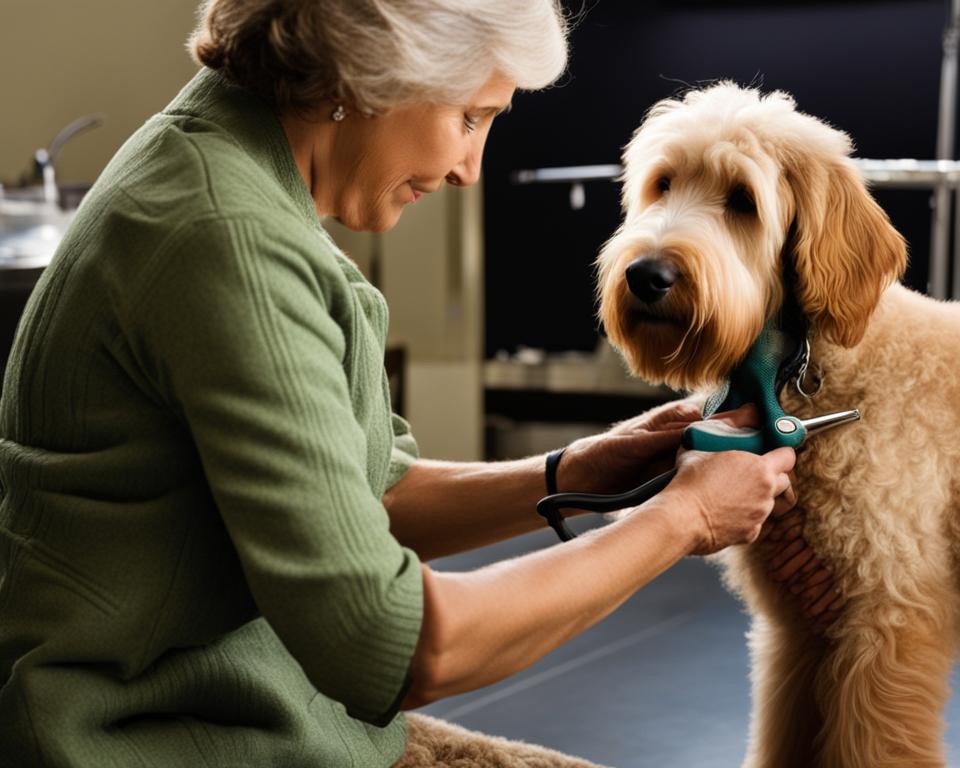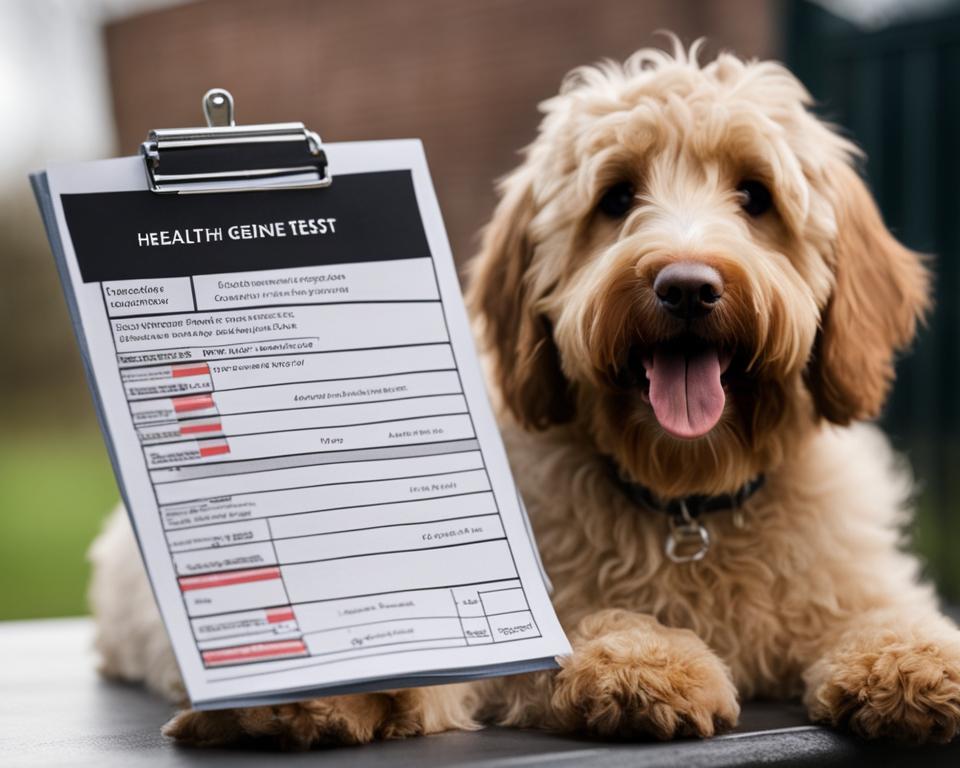Labradoodles are a popular breed known for their friendly nature and hypoallergenic coats. If you’re considering getting a Labradoodle as a pet, it’s important to understand the breeding practices that reputable breeders follow to ensure the health and well-being of their puppies.
Labradoodle breeders play a critical role in producing genetically superior puppies. They follow specific protocols to ensure that only healthy and well-tempered dogs are used for breeding. By understanding these breeding practices, you can make an informed decision when choosing a Labradoodle puppy.
Key Takeaways:
- Labradoodles are bred by knowledgeable breeders who prioritize the health and temperament of the puppies.
- Breeders conduct genetic and structural health testing to ensure the parents have proper health clearances.
- Understanding the importance of the furnishings gene helps breeders produce puppies that meet breed standards.
- Proper identification and testing of Labradoodle generations prevent confusion and ensure accurate labeling.
- Responsible breeders prioritize socialization, grooming, and provide ongoing support and health guarantees to new puppy owners.
Testing for Genetic Health
In order to ensure the health and well-being of Labradoodle puppies, genetic health testing is of utmost importance. By conducting thorough genetic testing, breeders can identify potential hereditary diseases and make informed breeding decisions. Common health issues in Labradoodles include hip and elbow dysplasia, epilepsy, Addison’s disease, and progressive retinal atrophy.
Structural evaluations, such as hip and elbow x-rays, are crucial for identifying potential issues related to joint health. These evaluations help breeders determine if the parent dogs have sound and healthy bone structures, ensuring that the puppies have a lower risk of developing conditions like dysplasia.
In addition to structural evaluations, breeders should also prioritize genetic testing to determine the genetic health status of the parent dogs. Genetic testing can reveal if a Labradoodle is clear, a carrier, or affected by hereditary diseases. Breeding dogs affected by these diseases should be avoided, while breeding carriers can be acceptable with careful mate selection.
Genetic Health Testing Methods
The most common genetic tests for Labradoodles include:
- DNA testing for hereditary diseases
- Microscopic evaluation of blood samples
Benefits of Genetic Health Testing
Genetic health testing offers several benefits:
- Identifying potential hereditary diseases, allowing breeders to make informed breeding decisions
- Reducing the risk of passing on genetic diseases to future generations
- Ensuring the overall health and well-being of Labradoodle puppies
By prioritizing genetic health testing, breeders contribute to the development of a healthier Labradoodle population. This ultimately leads to happier and healthier dogs for families to adopt.
| Disease | Description |
|---|---|
| Hip and Elbow Dysplasia | A condition where the hip or elbow joint doesn’t develop properly, leading to pain, lameness, and arthritis. |
| Epilepsy | A neurological disorder characterized by recurring seizures. |
| Addison’s Disease | A hormonal disorder that affects the adrenal glands and can cause weakness, lethargy, and gastrointestinal issues. |
| Progressive Retinal Atrophy | A degenerative disease that causes progressive vision loss and can lead to blindness. |
Proper Identifying of Labradoodle Generations
Properly identifying Labradoodle generations is essential in breeding. It ensures accuracy and avoids confusion among potential buyers. When it comes to multigenerational Labradoodles, it’s important to understand the criteria for labeling a dog as such.
To be considered a true multigenerational Labradoodle, both parents must be at least F3 or higher. Lower generations, such as F1 or F1B Labradoodles, do not meet the criteria for multigen status. Breeders should be well-versed in different generations and the significance of the generation of parents when producing puppies.
Accurate labeling of Labradoodle generations helps prospective buyers make informed decisions based on their preferences. When breeders properly identify the generations, it provides transparency and ensures that buyers know exactly what they are getting.
Knowing the Labradoodle generations is also important for breeders when it comes to selecting their breeding stock. By understanding the generations, breeders can make informed decisions to produce the desired traits and characteristics in their puppies.
Labradoodle Generations Overview
Labradoodle generations are typically denoted using the letter F followed by a number. Here is an overview of some common Labradoodle generations:
| Generation | Description |
|---|---|
| F1 | The first-generation cross between a Labrador Retriever and a Poodle. These Labradoodles are 50% Poodle and 50% Labrador Retriever. |
| F1B | The backcross of an F1 Labradoodle with a Poodle. These Labradoodles are 75% Poodle and 25% Labrador Retriever. |
| F2 | The result of breeding two F1 Labradoodles. These Labradoodles are 50% Poodle and 50% Labrador Retriever. |
| F2B | The backcross of an F2 Labradoodle with a Poodle. These Labradoodles are 62.5% Poodle and 37.5% Labrador Retriever. |
| F3 and higher | These Labradoodles are considered multigenerational and result from breeding Labradoodles with other multigenerational Labradoodles. They have a higher percentage of Poodle genes and more consistent traits. |
Understanding Labradoodle generations and their significance ensures that both breeders and potential buyers are on the same page. When it comes to breeding Labradoodles, accurate labeling and knowledge of the generations can lead to successful outcomes and satisfied puppy owners.
Breeding Labradoodles
When it comes to breeding Labradoodles, ensuring the health and temperament of the parent dogs is vital. This process involves several important steps, including:
- Obtaining Health Clearances: Before breeding Labradoodles, it is crucial to ensure that both the dam and sire have undergone thorough health clearances. These clearances typically include screenings for common genetic conditions such as hip dysplasia, elbow dysplasia, and eye diseases. Clearing the dogs of these conditions helps minimize the risk of passing them onto the puppies.
- Registering with Kennel Clubs: Reputable Labradoodle breeders often register their dogs and litters with recognized kennel clubs, such as the American Kennel Club (AKC) or the Australian Labradoodle Association (ALA). This helps establish the pedigree and lineage of the puppies, providing potential owners with assurance of their quality.
- Obtaining Necessary Licenses: Depending on the local regulations and laws, breeders may need to obtain specific licenses and permits to legally breed Labradoodles. These licenses ensure that breeders meet certain standards and promote responsible breeding practices.
Labradoodle pregnancies usually last around two months, during which the pregnant dogs require regular veterinary check-ups to monitor their health and the development of the puppies. A healthy diet, exercise, and proper prenatal care are essential during this time to support the well-being of both the mother and the growing puppies.
As the due date approaches, breeders must be prepared for the whelping process, which is the term used to describe the labor and delivery of the puppies. It is crucial for breeders to be familiar with the signs of labor, such as restlessness, nesting behaviors, and a decrease in appetite. Additionally, they should be prepared to address any potential complications that may arise during whelping.
Here is a table summarizing the breeding process for Labradoodles:
| Step | Description |
|---|---|
| Obtaining Health Clearances | Ensuring both the dam and sire have passed thorough health screenings for genetic conditions. |
| Registering with Kennel Clubs | Registering the dogs and litters with recognized kennel clubs to establish pedigree. |
| Obtaining Necessary Licenses | Obtaining the required licenses and permits to legally breed Labradoodles. |
| Pregnancy Care | Providing regular veterinary check-ups, a healthy diet, and proper prenatal care for the pregnant dog. |
| Whelping | Being prepared for the labor and delivery process, addressing any potential complications. |
During the whelping process, breeders should have the necessary supplies ready, such as whelping boxes, clean towels, and heating pads. It is also recommended to have the contact information of an emergency veterinarian readily available in case of any emergencies or complications that may arise.
Now that we have covered the breeding process, let’s move on to exploring the role of breeders in Labradoodle health and behavior.
The Role of Breeders in Labradoodle Health and Behavior
Breeders play a crucial role in shaping the health and behavior of Labradoodles. They have a responsibility to prioritize the well-being of their puppies and ensure that they are set up for a happy and fulfilling life. In this section, we will explore the key areas where breeders contribute to the development of Labradoodles, including temperament, socialization, and grooming.
Temperament
The temperament of a Labradoodle is influenced by genetics and early experiences. Good breeders are mindful of this and work to produce puppies with stable and friendly temperaments. By selecting parent dogs with desirable personality traits, breeders lay the foundation for puppies that are well-suited to become beloved family members.
Socialization
Socialization is a critical aspect of a Labradoodle’s development. Breeders play an important role in exposing puppies to various experiences, environments, and people from an early age. Proper socialization helps puppies grow into confident and well-adjusted dogs, capable of navigating different situations with ease.
Good breeders often implement a socialization program that introduces puppies to everyday sights, sounds, and experiences. This may include interactions with other animals, exposure to different surfaces and textures, and desensitization to noise. By providing these opportunities, breeders help puppies develop into sociable and adaptable companions.
Grooming
Grooming requirements for Labradoodles can vary depending on their coat type. Responsible breeders educate new puppy owners on proper grooming practices to minimize the risk of coat matting and skin issues. Whether a Labradoodle has a fleece, wool, or hair-like coat, breeders provide guidance on grooming techniques, frequency, and maintenance.
Additionally, breeders inform owners about the importance of regular brushing, bathing, ear cleaning, and nail trimming to ensure the overall health and appearance of Labradoodles. By instilling these grooming practices early on, breeders contribute to the well-being and comfort of the puppies they produce.

In summary, breeders play a significant role in shaping the health and behavior of Labradoodles. Through careful selection of parent dogs with desirable temperaments, prioritizing socialization, and providing grooming guidance, breeders contribute to the overall well-being and happiness of the puppies they bring into the world.
Considerations When Breeding Labradoodles
When breeding Labradoodles, there are several key considerations that breeders should keep in mind to ensure the production of healthy and desirable puppies. These considerations include factors such as size, color, coat type, genetic traits, and pricing.
Desired Size, Color, and Coat Type
Labradoodles come in a variety of sizes, colors, and coat types. Breeders should have a clear understanding of the specific attributes they are aiming for in their breeding program. Whether it’s a small, medium, or standard size, coats that range from curly to wavy, or colors that include cream, chocolate, or parti, breeders must carefully select parent dogs that possess these desired traits. This helps ensure that the resulting puppies will meet the expectations of potential buyers.
Dominant and Recessive Genes
A proper understanding of dominant and recessive genes is crucial for Labradoodle breeders. By knowing which traits are dominant and which are recessive, breeders can better predict the traits that puppies are likely to inherit. This knowledge allows breeders to make informed decisions when selecting parent dogs for their breeding program, resulting in puppies that possess the desired characteristics.
Backcrossing for Genetic Diversity
Backcrossing is a breeding technique that involves crossing a Labradoodle with either a Labrador Retriever or a Poodle. This technique helps maintain a diverse gene pool and can be beneficial for producing puppies with desired traits. Breeders should carefully consider when and how to incorporate backcrossing into their breeding program to achieve the best results.
Pricing Considerations
The pricing of Labradoodle puppies can vary based on several factors. These factors may include the lineage of the parent dogs, the specific coat color, and the reputation of the breeder. Breeding Labradoodles responsibly and ethically requires significant investments of time, resources, and expertise from breeders. As a result, the pricing of Labradoodle puppies may reflect these considerations. However, potential buyers should be cautious of purchasing from illegal breeders or puppy mills, as they may not prioritize the health and well-being of the puppies.
Overall, breeding Labradoodles requires careful consideration of various factors, such as size, color, coat type, genetic traits, and pricing. By paying attention to these considerations, breeders can increase the chances of producing healthy, desirable puppies that will bring joy to their future owners.

The Impact of Breeder Practices on Labradoodle Puppies
When it comes to Labradoodle puppies, the practices of the breeder make a significant impact on their health and overall well-being. Responsible breeders play a crucial role in ensuring that the puppies are healthy and have stable temperaments. Let’s take a closer look at how breeder practices influence Labradoodle puppy health, temperament, and breeding ethics.
Puppy Health
Responsible breeders prioritize the health of their Labradoodle puppies. They conduct thorough health screenings of the parent dogs, which often include genetic testing for common hereditary diseases. By selecting breeding pairs with good health clearances, breeders can reduce the risk of passing on genetic health issues to the puppies. This proactive approach helps ensure that Labradoodle puppies start their lives with the best possible health prospects.
Puppy Temperament
Well-bred Labradoodle puppies tend to have stable and balanced temperaments. This is because responsible breeders carefully select parent dogs with good temperaments, focusing on characteristics such as friendliness, intelligence, and adaptability. By breeding dogs with desirable temperaments, breeders can increase the likelihood of producing puppies that are well-suited for various households and lifestyles. Puppies from reputable breeders are more likely to grow up into confident and well-behaved adults.
Breeding Ethics
Ethical breeding practices are crucial in the Labradoodle community. Responsible breeders prioritize the welfare of their dogs and the integrity of the breed. They adhere to breed standards, including characteristics such as the furnishings gene, which gives Labradoodles their distinctive coat features. Breeders who follow ethical practices accurately label the generations of Labradoodles they breed, ensuring clarity and transparency for potential buyers. Ethical breeders prioritize the long-term health and well-being of Labradoodles, dedicating themselves to preserving the breed’s positive traits and genetic diversity.
Choosing a reputable and responsible breeder is crucial for the long-term happiness and health of your Labradoodle. By selecting a breeder who practices proper health testing, prioritizes good temperaments, and adheres to ethical breeding practices, you can have confidence in the quality and well-being of the Labradoodle puppy you bring home.
Conclusion
Understanding the breeding practices for Labradoodles is crucial for anyone considering getting a Labradoodle as a pet. Responsible breeding practices ensure the production of genetically superior puppies with good health and stable temperaments.
By choosing a reputable and knowledgeable breeder, potential owners can ensure that they are getting a Labradoodle that will bring happiness and companionship for years to come.
Labradoodles are beloved for their friendly nature, intelligence, and hypoallergenic coats. However, it’s essential to support breeders who prioritize the health and well-being of these dogs. Responsible breeders conduct genetic and health testing, properly identify Labradoodle generations, and play a role in the socialization and grooming of the puppies they produce.
When obtaining a Labradoodle, it is important to research and find a breeder who follows these practices. This ensures that you are not only getting a wonderful companion but also supporting ethical breeding standards in the Labradoodle community.
FAQ
What are some important considerations for Labradoodle breeders?
Labradoodle breeders should follow proper breeding practices and conduct genetic and structural health testing. They should also understand the importance of the furnishings gene and accurately identify the generations of Labradoodles they are breeding.
Why is genetic health testing important in Labradoodle breeding?
Genetic health testing helps ensure that Labradoodle puppies are free from hereditary diseases such as hip and elbow dysplasia, epilepsy, Addison’s disease, and progressive retinal atrophy. It allows breeders to make informed decisions about which dogs to breed.
How can breeders accurately identify Labradoodle generations?
True multigenerational Labradoodles should come from parents that are F3 or higher. Lower generations do not meet the criteria to be labeled as multigens. Breeders should be knowledgeable about different generations and accurately label their puppies.
What should breeders consider during the Labradoodle breeding process?
Breeders should ensure the health and temperament of the parent dogs by obtaining health clearances, registering with kennel clubs, and obtaining necessary licenses. They should also be prepared for the whelping process and the potential complications that may arise.
How do breeders impact the health and behavior of Labradoodles?
Responsible breeders prioritize proper socialization of puppies and educate new owners on grooming practices. They play a significant role in ensuring that Labradoodles grow up well-adjusted and friendly.
What factors should breeders consider when breeding Labradoodles?
Breeders should consider factors such as desired size, color, and coat type. They should be aware of dominant and recessive genes and may use backcrossing to maintain a diverse gene pool. Pricing can vary based on factors such as lineage and coat color.
How do breeder practices impact Labradoodle puppies?
Responsible breeders produce puppies with better health and stable temperaments. Poor breeding practices can result in puppies with health problems and behavioral issues. Choosing a reputable and responsible breeder is crucial for the long-term happiness and health of a Labradoodle.

Leave a Reply